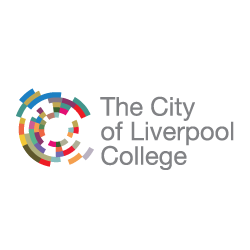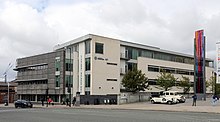
Liverpool is a city and metropolitan borough in Merseyside, northwest England. It had a population of 496,770 in 2022. The city is located on the eastern side of the Mersey Estuary, adjacent to the Irish Sea, and is approximately 178 miles (286 km) from London. Liverpool is the fifth largest city in the United Kingdom, the largest settlement in Merseyside and part of the Liverpool City Region, a combined authority with a population of over 1.5 million.

Imperial College London is a public research university in London, England. Its history began with Prince Albert, consort of Queen Victoria, who envisioned a cultural area that included the Royal Albert Hall, the Victoria and Albert Museum, the Natural History Museum and several royal colleges. Established by royal charter in 1907, Imperial College London unified into one institution the Royal College of Science, the Royal School of Mines and the City and Guilds of London Institute. In 1988, the Imperial College School of Medicine was formed by merging with St Mary's Hospital Medical School. In 2004, Queen Elizabeth II opened the Imperial College Business School.

The University of Southampton is a public research university in Southampton, England. Southampton is a founding member of the Russell Group of research-intensive universities in the United Kingdom.

The University of Liverpool is a public research university in Liverpool, England. Founded as a college in 1881, it gained its Royal Charter in 1903 with the ability to award degrees, and is also known to be one of the six 'red brick' civic universities, the first to be referred to as The Original Red Brick. It comprises three faculties organised into 35 departments and schools. It is a founding member of the Russell Group, the N8 Group for research collaboration and the university management school is triple crown accredited.

Liverpool John Moores University is a public research university in the city of Liverpool, England. The university can trace its origins to the Liverpool Mechanics' School of Arts, established in 1823. This later merged to become Liverpool Polytechnic. In 1992, following an Act of Parliament, the Liverpool Polytechnic became what is now Liverpool John Moores University. It is named after Sir John Moores, a local businessman and philanthropist, who donated to the university's precursor institutions.

St Mary's Hospital is an NHS hospital in Paddington, in the City of Westminster, London, founded in 1845. Since the UK's first academic health science centre was created in 2008, it has been operated by Imperial College Healthcare NHS Trust, which also operates Charing Cross Hospital, Hammersmith Hospital, Queen Charlotte's and Chelsea Hospital and the Western Eye Hospital.

The Royal Liverpool University Hospital (RLUH) is a major teaching and research hospital located in the city of Liverpool, England. It is the largest and busiest hospital in Merseyside and Cheshire, and has the largest emergency department of its kind in the UK.

John Moores Students' Union (JMSU) is the students' union of Liverpool John Moores University (LJMU) in Liverpool, England; membership is automatic upon enrolment within the university.
The National Oceanography Centre (NOC) is a marine science research and technology institution based across two sites, one in Southampton and one in Liverpool, England. It is the UK’s largest institution for integrated sea level science, coastal and deep ocean research and technology development. The Centre was established to promote co-operation with institutions across the UK marine science community, to better address key issues including sea level change, the ocean's role in climate change, computer simulation of the ocean's behaviour, and the long term monitoring and future of the Arctic Circle.

The City of Liverpool College is a further education and higher education college in Liverpool, England.
Benny Josef Peiser is a social anthropologist specialising in the environmental and socio-economic impact of physical activity on health. He was a senior lecturer in the School of Sport and Exercise Sciences at Liverpool John Moores University (LJMU) and is a visiting fellow at the University of Buckingham.
The IM Marsh Campus is a former university campus in south Liverpool. It was, until 2021, home to the School of Education, Leisure and Sport Studies and the School of Teacher Education and Professional Learning, of Liverpool John Moores University.

The former Proudman Oceanographic Laboratory (POL) is based in Brownlow Street, Liverpool, England. In April 2010, POL merged with the National Oceanography Centre, Southampton (NOCS) to form the National Oceanography Centre. The Liverpool laboratory's scientific research focuses on oceanography encompassing global sea-levels and geodesy, numerical modelling of continental shelf seas and coastal sediment processes. This research alongside activities of surveying, monitoring, data management and forecasting provides strategic support for the wider mission of the Natural Environment Research Council.

Liverpool city centre is the commercial, cultural, financial and historical centre of Liverpool and the Liverpool City Region, England. Different definitions of the city centre exist for urban planning and local government, however, the border of Liverpool city centre is broadly marked by the inner city districts of Vauxhall, Everton, Edge Hill, Kensington and Toxteth.

The Avril Robarts Library (formerly the Avril Robarts Learning Resource Centre (LRC)) is one of the two designated libraries belonging to Liverpool John Moores University (LJMU) in Liverpool, England. It stands at 79 Tithebarn Street and serves the City Campus located mostly on Byrom Street.

The Aldham Robarts Library (formerly the Aldham Robarts Learning Resource Centre (LRC)), is one of two designated libraries belonging to Liverpool John Moores University (LJMU) in Liverpool, England. It is located at Maryland Street and serves the Mount Pleasant Campus situated in Liverpool's Knowledge Quarter. Designed by the architectural firm Austin-Smith:Lord and built in 1994, the Aldham Robarts Library has won numerous architectural awards. The four-storey, 5,324 m2 (57,310 sq ft) building contains 386 personal computers alongside countless books and online catalogues that cater mainly for the Faculty of Arts, Professional and Social Studies and the Faculty of Business and Law. Wi-Fi is available throughout the complex, which can be entered by scanning a relevant student ID card by the ground floor turnstiles. Other services available in the Library include research and learner support. The Aldham Robarts Library is open 7 days a week during term time.

The John Lennon Art and Design Building in Liverpool, England, houses Liverpool John Moores University's School of Art and Design. The school was formerly located at the Grade II listed Liverpool College of Art, which now houses LJMU's School of Humanities and Social Science.

Edinburgh BioQuarter is an initiative in the development of Scotland's life sciences industry, which, as of August 2020, employs more than 39,000 people in over 750 organisations.
Professor Nigel Peter Weatherill, BSc, PhD, DSc, FIMA, C.Math, FRAeS, C.Eng, C.Sci, FREng, FRSA, DL is the former Vice-Chancellor and Chief Executive of Liverpool John Moores University (2011-2018).

The Astrophysics Research Institute (ARI) is an astronomy and astrophysics research institute in Merseyside, UK. Formed in 1992, it stood on the Twelve Quays site in Birkenhead from 1998 until June 2013 when it relocated to the Liverpool Science Park in Liverpool. It is in the top 1% of institutions in the field of space science as measured by total citations.




































